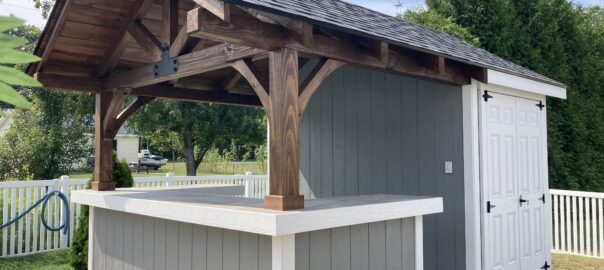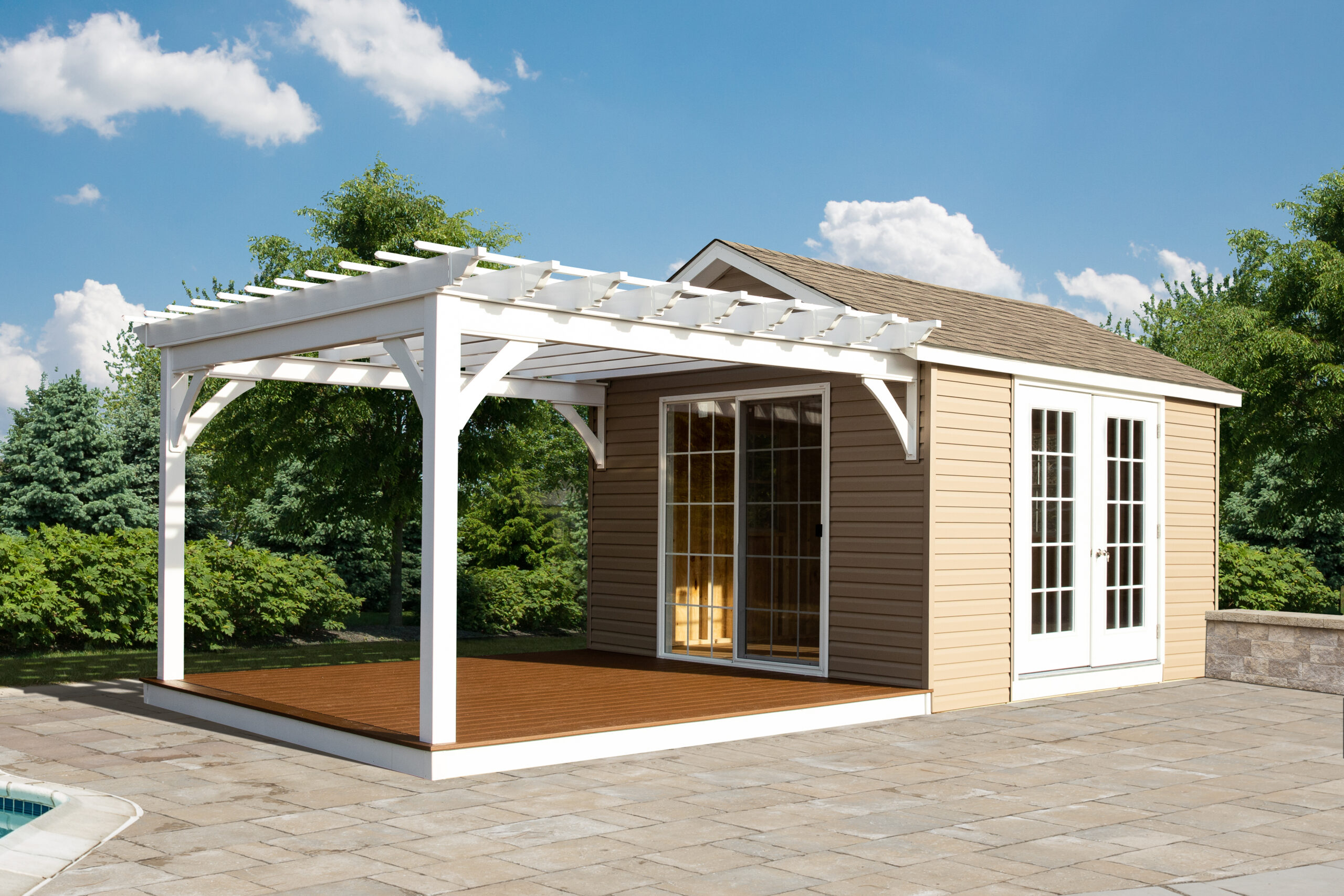Both Tiki and poolside bars offer distinct advantages and unique experiences when creating an outdoor oasis. Each type of bar has its own charm, design elements, and ambiance that can transform your backyard into a lively entertainment space.
Understanding the differences and benefits of each can help you decide which is the best fit for your lifestyle and outdoor space. In this blog post, we take an in-depth look at Tiki and poolside bars, covering design, ambiance, functionality, and more. Let’s get started!
1. Origins and Themes
Tiki Bar
Tiki bars originated in the 1930s in the United States and were inspired by Polynesian culture. They became famous post-World War II, fueled by Americans’ fascination with the South Pacific. DIY Tiki bars are characterized by their exotic, tropical ambiance, featuring bamboo furniture, thatched roofs, Tiki statues, and vibrant tropical decor. The theme is deeply rooted in escapism, offering a whimsical and immersive experience.
Poolside Bar
Poolside bars are a modern concept, evolving from the trend of luxurious resort amenities. They are designed to provide convenience and refreshment within the proximity of a swimming pool. The theme of a poolside bar is more flexible and can range from minimalist and sleek to tropical and colorful. The primary focus is relaxation and accessibility, often incorporating water- resistant elements that are easy to maintain.
2. Design and Decor
Tiki Bar
Bamboo, thatch, reclaimed wood, and stone are commonly used materials. These elements create a rustic, island-inspired look. Key decor items include tiki torches, carved wooden statues, Tiki masks, and tropical plants. Brightly colored fabrics, bamboo curtains, and nautical accessories like fishing nets and seashells enhance the theme. Soft, ambient lighting is essential. String lights, lanterns, and torches create a warm, inviting glow that complements the tropical atmosphere.
Poolside Bar
Durable and weather-resistant materials like stainless steel, glass, and treated wood are preferred. These materials can withstand splashes and prolonged exposure to sunlight. Decor tends to be more streamlined and modern, though tropical touches like potted palms, colorful cushions, and umbrellas can be added. Sun loungers and waterproof cushions are common. Bright, functional lighting is necessary for safety. Underwater pool lights, LED strips, and task lighting around the bar area are typical.
3. Ambiance and Atmosphere
Tiki Bar
The ambiance is playful and immersive, designed to transport guests to a tropical paradise. Combining themed decor, exotic music, and tropical cocktails creates a festive and escapist environment. Traditional Hawaiian music, surf rock, and Exotica are popular choices.
Poolside Bar
The ambiance is laid-back and refreshing, focused on providing a relaxing retreat by the water. The presence of the pool adds a dynamic element to the atmosphere, making it perfect for casual gatherings and daytime lounging. Chill-out, beach house, and soft pop music are typical choices. The sound of water from the pool adds to the relaxing environment.
4. Functionality and Use
Tiki Bar
DIY Tiki bars are versatile and can serve as standalone entertainment areas. They are ideal for themed parties and serve a variety of tropical drinks and appetizers. Common features include a well-stocked bar with exotic cocktails, a small seating area, and sometimes a grill or outdoor kitchen. Tiki bars often have decorative elements that enhance the immersive experience, such as waterfalls or fire pits.
Poolside Bar
Poolside bars are designed for convenience and refreshment. They are perfect for pool parties and casual gatherings where guests can easily access drinks and snacks without leaving the pool area. Essential features include a wet bar, comfortable seating, and ample shade. Some poolside bars also incorporate swim-up bars, allowing guests to enjoy drinks while remaining in the water.
5. Installation and Maintenance
Tiki Bar
Building a Tiki bar can range from simple DIY projects to elaborate constructions. Basic Tiki bars can be set up with a few materials, while more complex designs might require professional help. Regular maintenance is needed to keep the materials in good condition. Bamboo and thatch must be treated for weather resistance, and the decor should be checked regularly for wear and tear.
Poolside Bar
Poolside bars can be more straightforward to install, especially if integrated into the pool design. Prefabricated units are available for easier setup. Maintenance focuses on keeping the area clean and ensuring that the materials withstand exposure to water and sunlight. Regular cleaning and occasional sealing of materials like wood are necessary.
6. Cost Considerations
Tiki Bar
The cost can vary widely based on the complexity of the design and the quality of materials used. A simple DIY Tiki bar might be inexpensive, while a custom-built bar with elaborate decor and features can be costly. To save money, consider using reclaimed materials and focusing on crucial decor pieces to create the Tiki atmosphere without overspending.
Poolside Bar
Costs for poolside bars also vary depending on the design and features. Simple setups are more affordable, while integrated swim-up bars and high-end materials can increase expenses. To manage costs effectively, opt for prefabricated bar units and invest in durable, weather-resistant furniture.
7. Personalization and Customization
Tiki Bar
Tiki bars offer a high degree of personalization. You can choose specific themes (such as
Hawaiian, Polynesian, or Caribbean) and customize the decor, drinks menu, etc.
Poolside Bar
A poolside bar also offers customization options such as choosing materials, seating
arrangements, shade structures, and beverage selections. You can tailor the design to match your aesthetic preferences, poolside decor, and functional needs, creating a unique and personalized outdoor entertaining space.
Making a Decision
When deciding between a Tiki bar and a poolside bar, consider your personal preferences,
available space, and the primary purpose of the bar. Here are some questions to help guide your decision:
1. What is your primary goal?
A tiki bar might be the better choice if you want to create a thematic and immersive experience. A poolside bar could be more suitable if you aim to enhance your pool area with added convenience and functionality.
2. Do you have a pool?
A poolside bar naturally complements a pool area and enhances the overall swimming
experience. A Tiki bar can be set up independently of a pool, offering more flexibility in
location.
3. What kind of ambiance do you prefer?
If you enjoy a tropical, exotic atmosphere with vibrant decor, go for a DIY Tiki bar. If you prefer a modern, clean look with practical features, a poolside bar may be more your style.
4. How much space do you have?
Evaluate the available space in your backyard or patio to determine which bar type fits better.
5. What is your budget?
Consider the cost of materials, construction, and maintenance for both types of bars. Tiki bars require more investment in themed decor, while poolside bars may need more durable and waterproof materials.
Are you looking for a Tiki or Poolside bar to add to your space?
With a Tiki or poolside bar, you’ll have a space to spark conversation with your friends while enjoying your favorite drinks. However, remember to invest in a high-quality structure that will stand the test of time. At Backyard Escapes, we have numerous Tiki and poolside bars for sale. We offer multiple options and design features. Contact us today, and we will deliver a fully assembled and ready-to-go Tiki or poolside bar.


